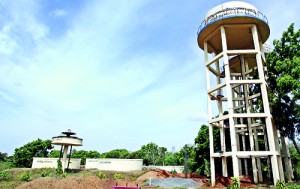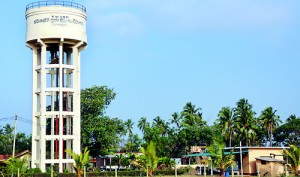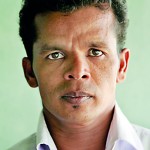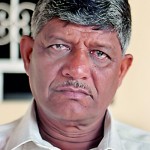News
People-centred Water Trust soon to be Govt. dept.
Weerasinghe Liyanagamage Ranjith, 42, greets us with a big smile. The smile is marred because his teeth are stained a dark brown.
Not only the staining of the teeth but numerous other issues had been the bane of the lives of a huge 1,500 families comprising about 5,000 men, women and children of Thunkama in Embilipitiya.

Thunkama water project. Pix by M.A. Pushpa Kumara
“Now, however, my children don’t have these problems,” points out Ranjith. For, he and his neighbours have laboured to put in place an invaluable water project maintained and managed within the village itself by a community-based organisation (CBO). This would ensure that future generations would not have to undergo the hardships they and those before them had faced to get a few essential cups of clean drinking water – a right which many in Sri Lanka take for granted.
In Sri Lanka, about 33% of the population gets its water directly from the NationalWater Supply and Drainage Board (NWSDB), while 11% are serviced entirely by CBOs such as Thunkama’s Suwadivi Prajamula Sanghwidhanaya, which fall under the National Community Water Trust, the Sunday Times learns. The other people get their water from rivers, wewas, canals, wells, tube wells or through rainwater harvesting.
But now the National Community Water Trust is at a crossroad – it is soon to be converted into a department, even after many in the water sector have raised serious reservations about the viability of such a move.
Ranjith who is President of the Thunkama community-based water project which secured the trophy as the best CBO in Sri Lanka at the World Water Day celebrations on March 22 at the BMICH, re-lives the water woes that had been their lot for many generations.
For 50 or more years, the people of Thunkama who eke out a living by paddy farming, banana cultivation, making bricks or working as labourers, suffered in silence without a basic necessity – clean drinking water.

Madurankuliya water project
Not only his mother but also his grandmother would walk the wearying seven kilometres to the Walawe Ganga to carry home their drinking water. They would balance the heavy pots on their heads every single day and bring back water for the family, amidst toiling at their daily chores of cooking, cleaning, washing clothes, look after the children and also helping their husbands in the field, Ranjith recalls. By 1960, their problems eased slightly with the Chandrika Wewa irrigation scheme becoming a reality, but not for all. “In some areas, the water could not be used for drinking because toxic agrochemicals were polluting it, while in other areas in wells, even as deep as 50 feet, there was kivula (hard water),” says Ranjith.
The pleadings to the NWSDB resulted in the people being registered, but there was no outcome. The villagers had wells sans clean drinking water and tractor owners had a thriving business by providing a 10-litre buliya (plastic can) of water at Rs. 350, that too about four days after a request was made.
Thunkama’s water-tale was not one being told in isolation. With the NWSDB concentrating on urban areas, many of the rural areas with their homes scattered across large swathes of land and hardly any accessible roads had been literally left high and dry.

Weerasinghe Liyanagamage Ranjith
Identifying the reality that sporadic efforts had not yielded the anticipated results while the demand for safe drinking water and sanitation was growing, the Government and international agencies launched the Community Water Supply and Sanitation Project (CWSSP) 1 from 1993-98, followed by CWSSP II (1999-2003) and Reactivated CWSSP II (2004-10).
“These projects are people-centred, demand-responsive and community planned, constructed, owned and managed,” explains Sarath Chandrasiri Vithana, Chief Executive Officer of the Water Trust.
Clean drinking water in the homes of the people of Thunkama for 24-hours a day became a reality at the end of 2010 under the Reactivated CWSSP.
By 2011, when the Water Trust was set up on December 30, 13 districts had been encompassed, with CBOs providing water to a huge 585,337 families amounting to 3.4 million people.
The Water Trust which brings under one umbrella, 2,252 community-based projects across the country, not only gives them an identity but also ensures the consistent flow of technical support from the NWSDB, says Mr. Vithana, adding that as of May 2014, there are 3,586 CBOs, with 1,334 needing to seek registration with the Water Trust.

P.V. Karunaratne
Headquartered at the Ministry of Water Supply and Drainage at ‘Lak Diya Medura’ in Pelawatte, Battaramulla, the Water Trust, has branch offices in several districts.While Mr. Vithana is CEO, the 11-member Water Trust comprises the ministry secretary (Chairman), representatives of the Finance and Provincial Council Ministries, NWSDB Chairman and General Manager, three experts in IT, Engineering, Water Supply & Sanitation and Community Development and three members representing the CBOs.
It is the office-bearers of the Madurankuliya CBO who explain to the Sunday Times, the arduous planning, implementation and management of the water project in their area.
“Jala ulpath nethiwela, ugra jala hingayak thibba,” says P.V. Karunaratne, President of the Madurankuliya Suwa Shakthi Ekabadda Prajamula Sanwidanaya, explaining that people began to experience severe water scarcities about 30 years ago with the springs drying up.
“The ground water was salty and could not be used for drinking. People had to go very far in search of drinking water, either on cycles or in carts to bring back kala-gedi full of water from distant wells. During the drought when those wells ran dry, they were at the mercy of the bowser owners,” said Secretary Gamini Jayasinghe who is also Principal of the Madurankuli Model School. Even the schools were not spared and the influx of displaced people from the north heightened the problems.
Like most areas affected by the lack of water, the people were an impoverished lot. Some were paddy or coconut cultivators, others were fishermen, while a majority led a hand-to-mouth existence as labourers on daily wages.
The water project was initiated in the grama niladhari divisions of Madurankuliya, Velusumanapura, Pubudugama and Weerapura, in the Puttalam area.
The Government contributed 80% of the cost to implement it, while the people had to chip in 20%, either in the form of money or labour.
The biggest hurdle was finding a source which they could tap for drinking water. The search ended seven miles away, beyond the lagoon and close to the sea in Thoduwawa. With the Catholic Church which owned the land leasing 12 perches, the project took off with two tube wells. The people soon set to work, cutting the drains and laying the network of pipelines. The filtering systems were put in place and the towers erected.
The water began to flow through the pipes into the homes on April 8, 2007, smiles Mr. Karunaratne, adding that now there are six tube wells. Two thousand families have benefited by the project, with more on the waiting list for water connections.
The success and sustainability of any community water project lie with the efficiency and transparency of the CBO’s Executive Committee, the Sunday Times learns. There are 13 women among the 35-member Executive Committee elected at the Maha Sabhawa. It also has members from the four religions and three races, says Mr. Karunaratne, implying the true reflection of Sri Lankan society.
Although the beginnings were in a small room, now this CBO has its own land with a nice office building. The water from the tube-well source is run through underground filtering systems, then chlorinated and sent to overhead towers, from where it is supplied to homes.
Growing from strength to strength, the CBO has purchased two generators to provide an uninterrupted 24-hour service, even when the national grid fails and there is a power-cut. It employs 10 people to man the office and the pumps, read the meters and issue bills.
The water supply system has brought about an improvement in sanitation and the CBO gives out interest-free loans amounting to Rs. 20,000 to a family to build a toilet. Loans are also available for water filters as well as water tanks.
The CBO also maintains the public toilet in Madurankuli as a service to people who gather in the town during the Sunday pola (fair).
Not only the Madurankuli and Thunkama CBOs but also many others are an example how well the water projects can be run, without interference or meddling from the authorities.
The ripple effects of the water projects have brought about development in the villages. The Thunkama CBO has given out Rs. 3.5 million as loans to its members for agricultural and business activity, while keeping Rs. 6.5m in fixed deposits and Rs. 1.5m for any emergency work at the project.
It is a similar story at Madurankuliya.
These CBOs’ recipe for success is holding regular annual meetings, having policies and guidelines and ensuring audited financial accounts.
However, there are issues with some of the CBOs when there is lack of transparency, concedes Mr. Vithana of the Water Trust.
Now that a department is to be formed, what of the future of a majority of thriving community-based water projects, as opposed to the mismanaged ones, is the question on the minds of many. Will it be the death knell for the CBOs and in its wake the collapse of a water supply system on which millions of people are dependent?
“We’ll have to wait and see,” says Mr. Vithana.

